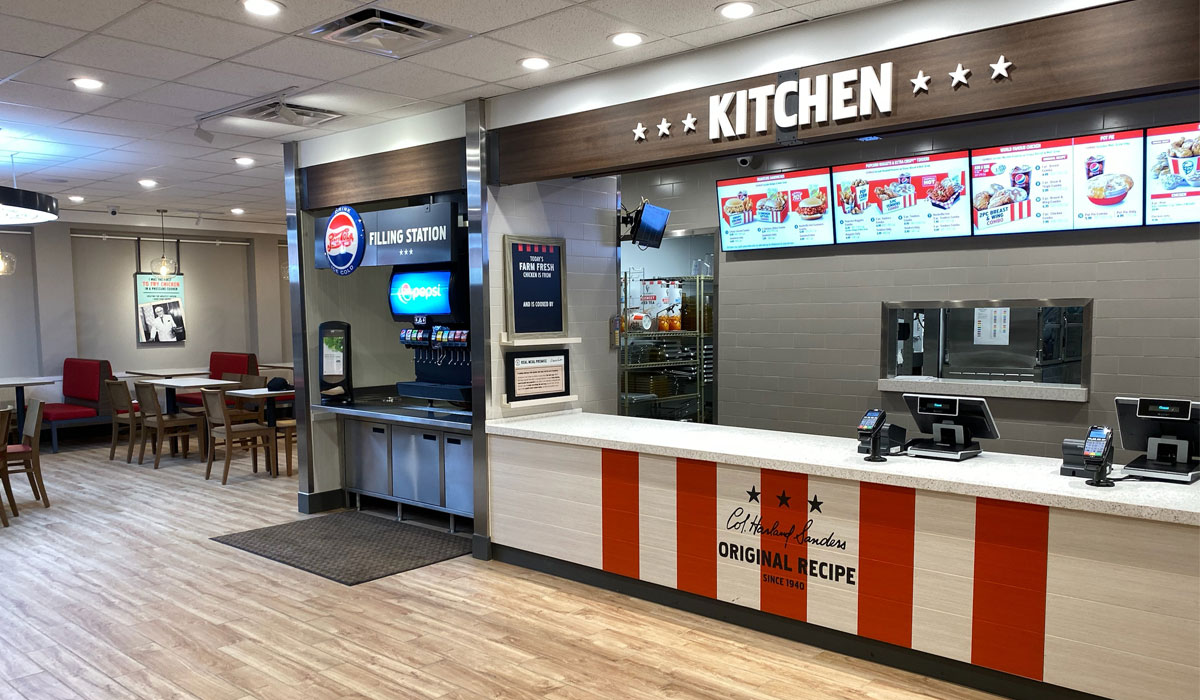KFC’s trailblazing chief operations officer, Monica Rothgery, calls it a gut check. You can’t just ask operators if something works. You have to threaten to take it away.
“A lot of times they’ll tell you what they think you want to hear,” Rothgery says from a test kitchen in the company’s Louisville, Kentucky, headquarters. “How’s it going? Great. There’s no problems. That doesn’t help us get better if they’re not honest.”
So, Rothgery, who is the first female COO in KFC’s history, and its first LGBT C-suite employee, will ask this instead: “Do you want to go back?”
It’s a question the legacy brand has asked itself repeatedly as it’s staged one of the most compelling fast-food comebacks of the past decade. Only, this is different. The right answer is “no.”
While much of KFC’s “Re-Colonization” efforts since 2016 centered on its DNA, and looking at brand positioning through the lens of infusing life into an iconic brand, not reinventing it, the chain’s latest full-throttle effort is a departure from recent practice. Although you could argue it’s also an ode to “the way things used to be.” Either way, as Rothgery’s question brings out of operators, KFC wants to ditch the recent past in favor of honoring the “Colonel standards,” it invested 100,000 hours of training on a few years back. The goal then was to tick up the quality quotient. Rothgery’s “Scoop to Order” project ratchets it to another level.
When her promotion was announced in May—Rothgery served as chief restaurant productivity officer since August 2018 and was KFC’s Thailand operations and people leader before that, growing the brand from 350 to 700 units—she immediately became the closer for one of KFC’s biggest culture changes in recent memory. Perhaps the largest since the roots-driven “Re-Colonization” plan unrolled in 2016 and brought the Colonel impersonators to life.
“Scoop to Order” is something few fast-food brands at this scale are attempting in today’s convenience and automation-frenzied world: It’s adding steps to the make-line during order completion. In the past, KFC employees grabbed items and arranged, putting a guests’ order into a recognizable, paper box. This notably included taking sides pre-prepacked earlier in the day off a warming station, already in small containers, and loading them in.
With “Scoop to Order,” live since April, workers, as the name illustrates, literally scoop each side for each individual order. It’s akin, in some ways, to the Chipotle-made-famous assembly line of open ingredient preparation. Only in KFC’s case, it’s happening in the back of the house in warming trays. A key, visual change: Instead of a box, KFC now serves up meals in open paper containers on a tray with a wood-themed design.
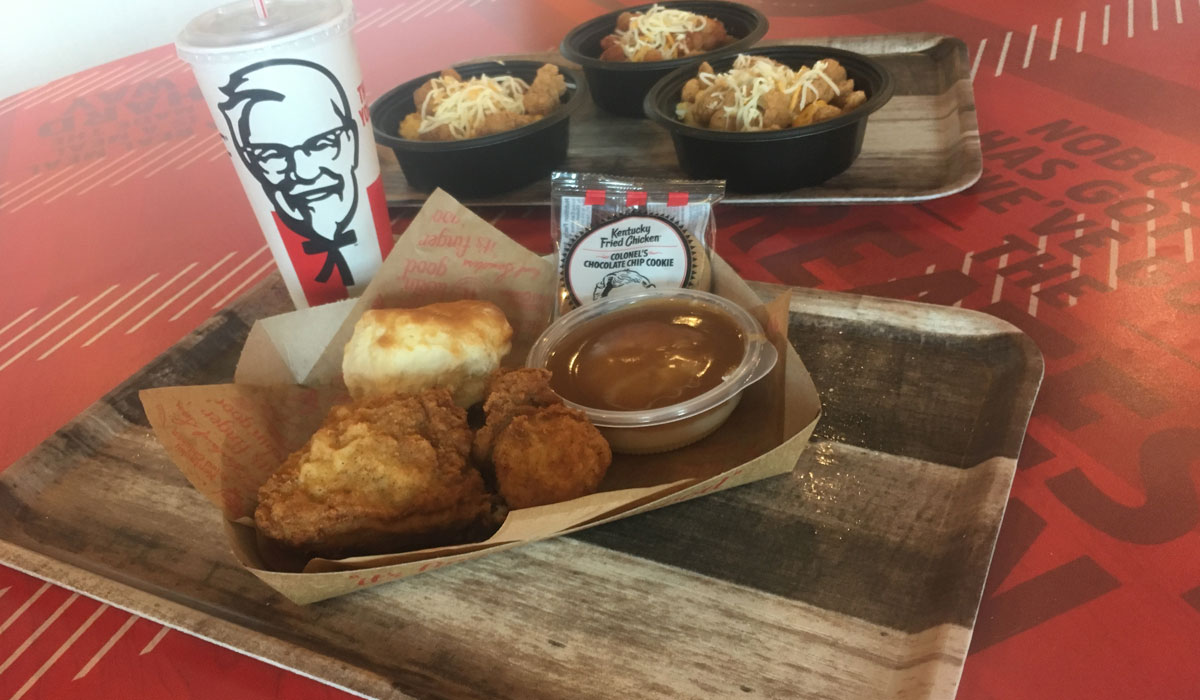
The reason for this is straight-lined, Rothgery says. “The changes come from a focus on improving guest experience,” she says.
The initiative was in development “for quite a while” before Rothgery assumed the reins, but she brought it home. And as Rothgery noted before, operators, understandably, recognized the move for what it was—a disruptive force they needed to adapt to. “This is so much behavior change and mindset change,” she says. “Change management is always the biggest hurdle. But once people believe and they can see the benefits then [I ask] do you want to go back?”
From Baltimore to California to Texas, Rothgery says, the answer has always been no.
My-Oahn Flowers, the general manager, or RGM (restaurant general manager) as KFC calls them, of the brand’s flagship Louisville store—one of only four in its 4,050-unit U.S. fleet—says “Scoop to Order” actually saved labor and improved productivity, despite what outside observers might think.
The reason being it took a preparation job that, admittedly, few relished, and reimagined it as something more valuable. Previously, an employee would show up early and prep those countless sides, methodically filling up containers. It was pain staking and unsatisfying work, and it wasn’t guest facing or dynamic. Also, KFC couldn’t portion control its product like it can now.
“It’s great,” Flowers says of the change. “It’s a hotter product. It’s more fresh.” She guessed it takes “5 and half seconds” to scoop mashed potatoes.
Rothgery echoes Flowers’ point. “The pride has been worth it,” she says. “The operators are super proud of this product.”
Having an employee assist their co-workers during busy times, serving meals, instead of standing in the walk-in scooping coleslaw each morning, boosted morale, Rothgery says. “It’s more fun at peak,” she says. “If you’re part of it as opposed to being in the freezer—they like the team essence of it.”
The move didn’t alter staffing levels. It also didn’t sag speed of service to any significant level, Rothgery says. As you would imagine, it lowers early but then picks up in efficiency over time. “They get better,” she says. “We’re seeing they actually get back to where they were before, or improve even.”
Additionally, “Scoop to Order” opened the product innovation window for KFC. On August 26, the chain plans to launch Mac & Cheese Bowls—its first addition to the $5 Fill Up Line in about a year—nationwide. The new setup naturally flows into this kind of creation, especially in regards to customization.
For instance, if a customer really wanted to put mac and cheese on a sandwich, this “Scoop to Order” process allows it. KFC can tweak SKUs and rethink menu ideation without some of the bottleneck concerns and limitations it had previously, when sides were prepacked in containers and ready for deployment as is.
Rocky and Bullwinkle?
Like many of YUM! Brands’ executives, Rothgery has been in the system for decades, not days. She started 1992 as a Taco Bell GM. Her career took a fateful twist the following year, although it felt like a cruel, fork-in-the-road joke at the time—a marketing campaign with cartoon classics Rocky and Bullwinkle.
Rothgery told this story recently at a convention, saying it served as the impetus for her career arc. One night, after closing, Rothgery opened the Rocky and Bullwinkle POP kit. It was three boxes and “100 parts.”
“It was like the IKEA of POP kits,” she quips.
It took two hours to set up. Rothgery cried. “I said if I ever survive this job and get promoted, I’m going to do whatever I can to make life easier for the people who work in the back of the restaurants.”
“And that’s what I spent the last three decades of my career trying to do,” she adds. “Just making it as easy and as pleasant and joyful of an experience as they can have.”
That offers some perspective into how much stock KFC puts behind “Scoop to Order.” The fact it’s willing to take those extra steps and scrap a simpler, comfortable method.
And it isn’t lost on Rothgery, either, what her historic hire represents. She says she thinks about it “every day.”
Rothgery was meeting with field leaders in California last week where two female staffers, an area coach and HR person, cornered her and “let me have it,” she says.
“I put my seatbelt on and they’re like, I hope you know we have a lot of expectations from you,” Rothgery says. “You’re our first female COO and we need you to support female leaders and get more women into franchisees and more women above restaurants. I’m like, guys, I’m not by myself.”
“They have high expectations that I carry a voice for them and do whatever I can to support that ongoing development,” she adds. “For all of our leaders, but especially our female leaders.”
A comeback story, in large bucket size
From 2011–2017, KFC shuttered more than 1,000 domestic restaurants. A decade before that, KFC was the seventh-biggest quick-service brand in America in terms of systemwide sales, topping chains like Chick-fil-A and Pizza Hut with figures of $5.3 billion. At the end of 2017, KFC was 13th.
The brand struggled through the Great Recession like many of its counterparts, fighting to hold share against emerging fast casuals that presented a more indulgent, yet economical outlet for consumers.
KFC’s “Re-Colonization” target was the start of a different narrative for KFC, however. And it’s only gained speed since. YUM! CEO Greg Creed even called the brand’s recent momentum “probably the broadest … we’ve had in KFC,” during YUM!’s second-quarter review in early August.
In Q2, the brand delivered its 16h consecutive quarter of positive same-store sales growth. KFC’s U.S. comps lifted 2 percent, year-over-year, while its international business boomed 6 percent. Impressively, KFC saw widespread strength across the world, leading to global system sales gains of 10 percent as net new unit expansion upped 6 percent. KFC opened 232 net new units in the quarter. The U.S. system has retracted by 25 stores so far in fiscal 2019, with 27 openings and 24 more under construction.
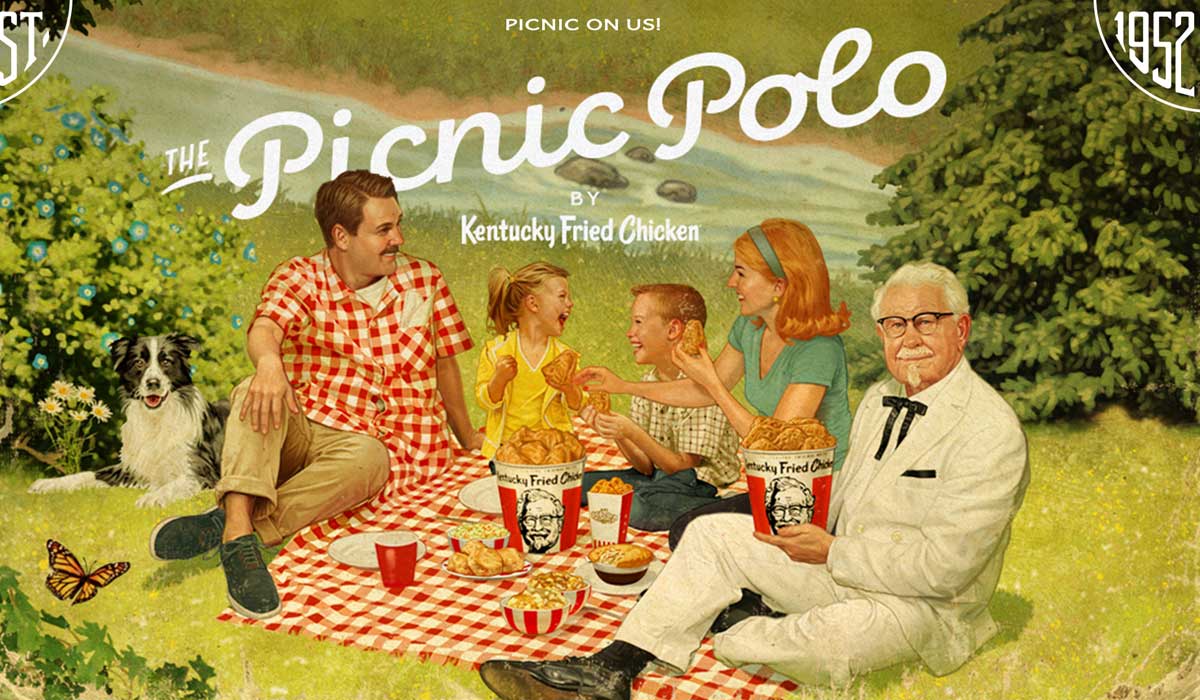
Eight out of 13 markets reported at or above 6 percent same-store sales gains for KFC in Q2. The brand’s average-unit volumes rose in 2018 to $1.21 million from $1.2 million the previous year.
This is all critical given the system breakdown, which is nothing new to YUM!
KFC finished last year with 4,019 franchises and 55 corporate units. The company simply can’t champion significant changes, at least not with the same weight behind them, without the support of its vast operator system.
And this all traces back to the aforementioned “Re-Colonization” push and what that entails.
Standing in KFC’s Colonel Sanders Museum near YUM!’s headquarters, located inside the Colonel’s old office, Lori Riddle Eberenz, the brand’s senior manager of public affairs, lays out the thinking. “This is where we were great, and let’s get back to when we were great,” she says.
Eberenz joined KFC right as the legacy turnaround kicked into gear. It was spearheaded by brand president Kevin Hochman, a marketing specialist himself. It’s hard to imagine KFC’s ad life before the carousel of celebrity Colonels. But that’s not overly surprising. The prior setup was as muted as today’s is vibrant.
Before the quirky skits, KFC featured an Orlando-based cook and had him hand-bread and fry chicken on-site.
Hochman told QSR earlier that “nobody even noticed it.”
“SNL” alum Darrell Hammond was tapped as the first Colonel impersonator and the start of an episodic marketing campaign began. KFC ran some tests a couple of years ago that suggested only 43 percent of fast-food ads were correctly linked to the corresponding brand. With its Colonel spots, KFC’s numbers nearly doubled at 74 percent.
Regardless of any other measuring stick, it’s hard to argue those commercials are KFC to its core, which is exactly the point. And something that was drifting listlessly before the “Re-Colonization” mantra locked in.
Now there’s everything from fried chicken scented Valentine’s Day cards to yule logs (also chicken scented) to 70s style racing jackets. Yule logs are currently selling for $150 on eBay.
And speaking to those 100,000 hours to retrain cooks, employees now get “chicken mastery certified” before they hit the floor. KFC also kicked the use of chicken treated with antibiotics for human medicine.
Then came the physical materialization of all these efforts. KFC’s Louisville flagship is an amplified version of its “American Showman,” redesign. The unit is only one of two to feature self-serve kiosks in-store and the lone unit with digital drive-thru menuboards that offer integrated order confirmation.
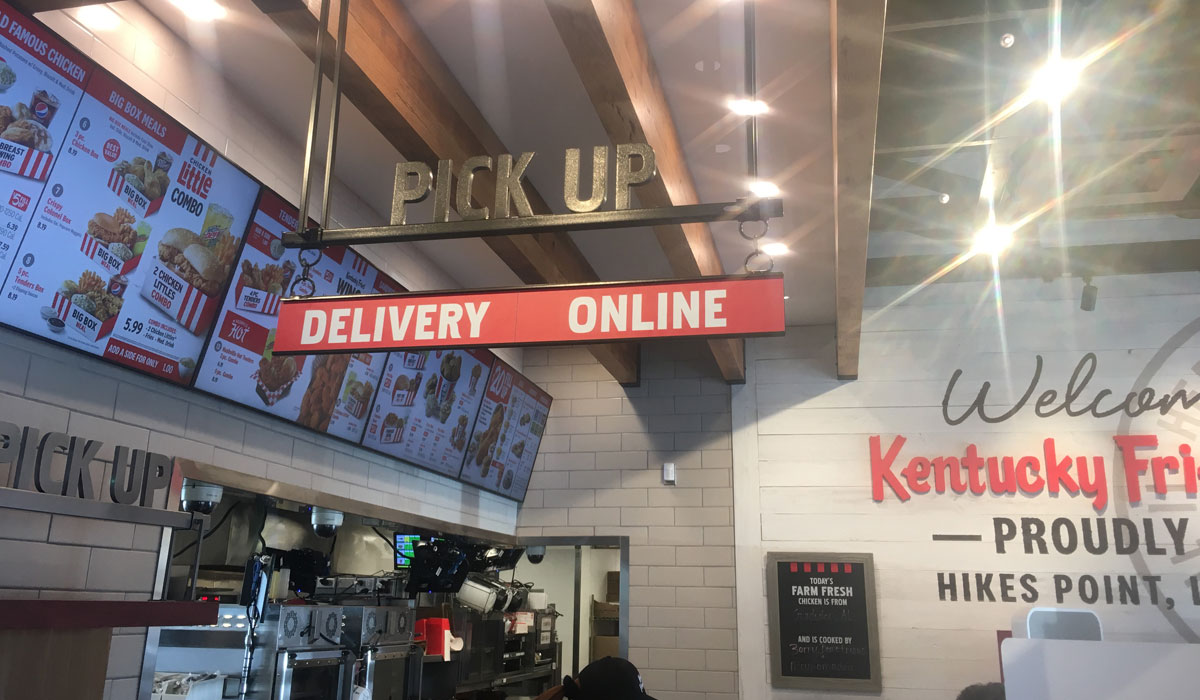
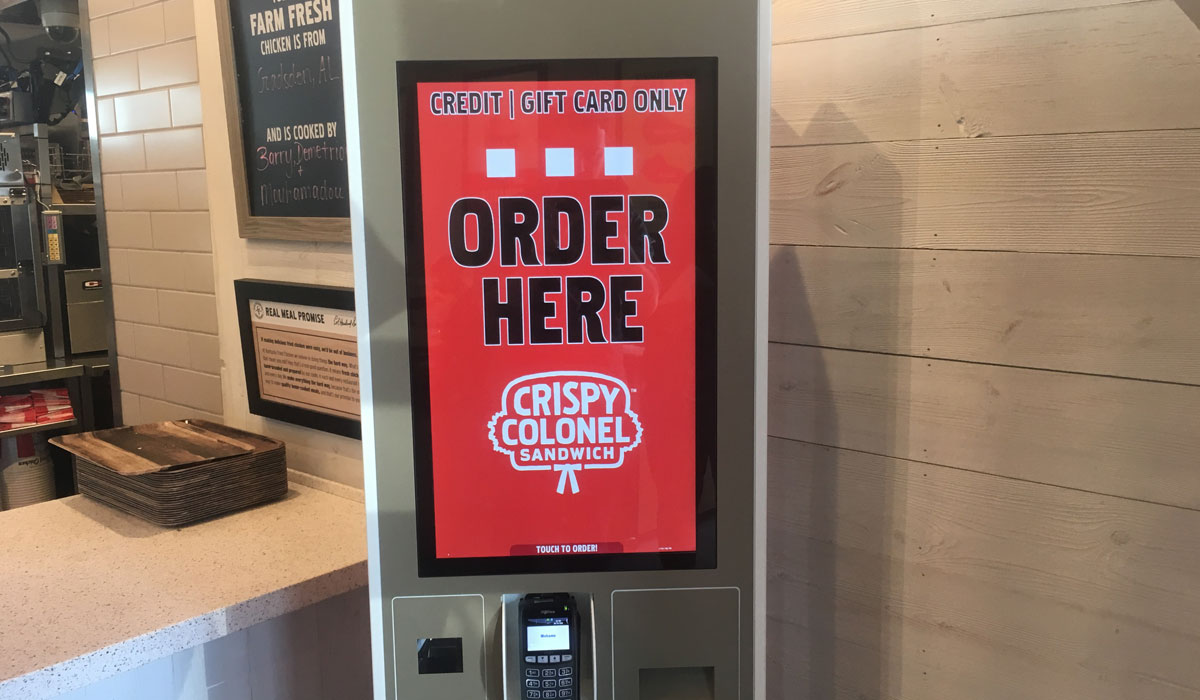
But as a whole, the updated look, which ratchets up the brightness of exterior stores with bright red-and-white stripes (like a chicken bucket), is in 1,700 locations, or roughly more than 40 percent of the domestic system. Year to date, KFC opened 253 remodels (104 last quarter) and has 70 currently under construction.
A big update, and this was, in some ways, a precursor to the “Scoop to Order,” mindset, are the chalkboards that show the name of the cook working that day, as well as the farm from which the chicken was sourced.
Show me the results
Creed, who is retiring at year’s end after 25 years with the company, credited “disruptive value coupled with amplified innovation, compounded by an effective digital and delivery strategy,” for KFC’s recent surge. He also shouted out brand CEO Tony Lowings’ efforts since taking the role. He succeeded Roger Eaton in September 2018. Not surprisingly, Lowings has been with YUM! 25 years, too.
[float_image image=”https://www.qsrmagazine.com/wp-content/uploads/2019/08/KFCGrub.jpg” width=”50″ link=”” caption=”KFC is now offering delivery via Grubhub at 2,293 restaurants.
” alt=”” align=”left” /]
This past quarter, in the U.S., KFC continued to focus on core menu items balanced with an accelerated pace of promotion—a strategy that has matured nicely in recent periods. Q2 began with Chicken & Waffles and then added Cinnabon Biscuits. On the value side, KFC launched a new channel for a la carte menu items, the 2 for $6 Mix ‘n’ Match. Creed said the proposition drove transactions and allowed guests flexibility to build their own meals.
“We have been focused on driving what we call one extra transaction, one extra occasion from a frequency point of view,” Creed said during the Q2 call. Driving reach and penetration, and, in turn, broadening KFC’s user base.
In YUM’s KFC’s offices, tech employees keep a tally of initiatives. At last glance, manager devices were in 1,676 restaurants. Delivery through Grubhub, a company YUM! holds a $200 million stake in, at 2,293 restaurants. Grubhub click-and-collect was also up and running at 3,544 venues.
All of these updates, and more, have space to climb, which is a promising proposition for KFC.
“And while each market is unique, the recipe for success has a consistent theme,” Creed said.
And that’s something KFC doesn’t need to lock away in a vault.

